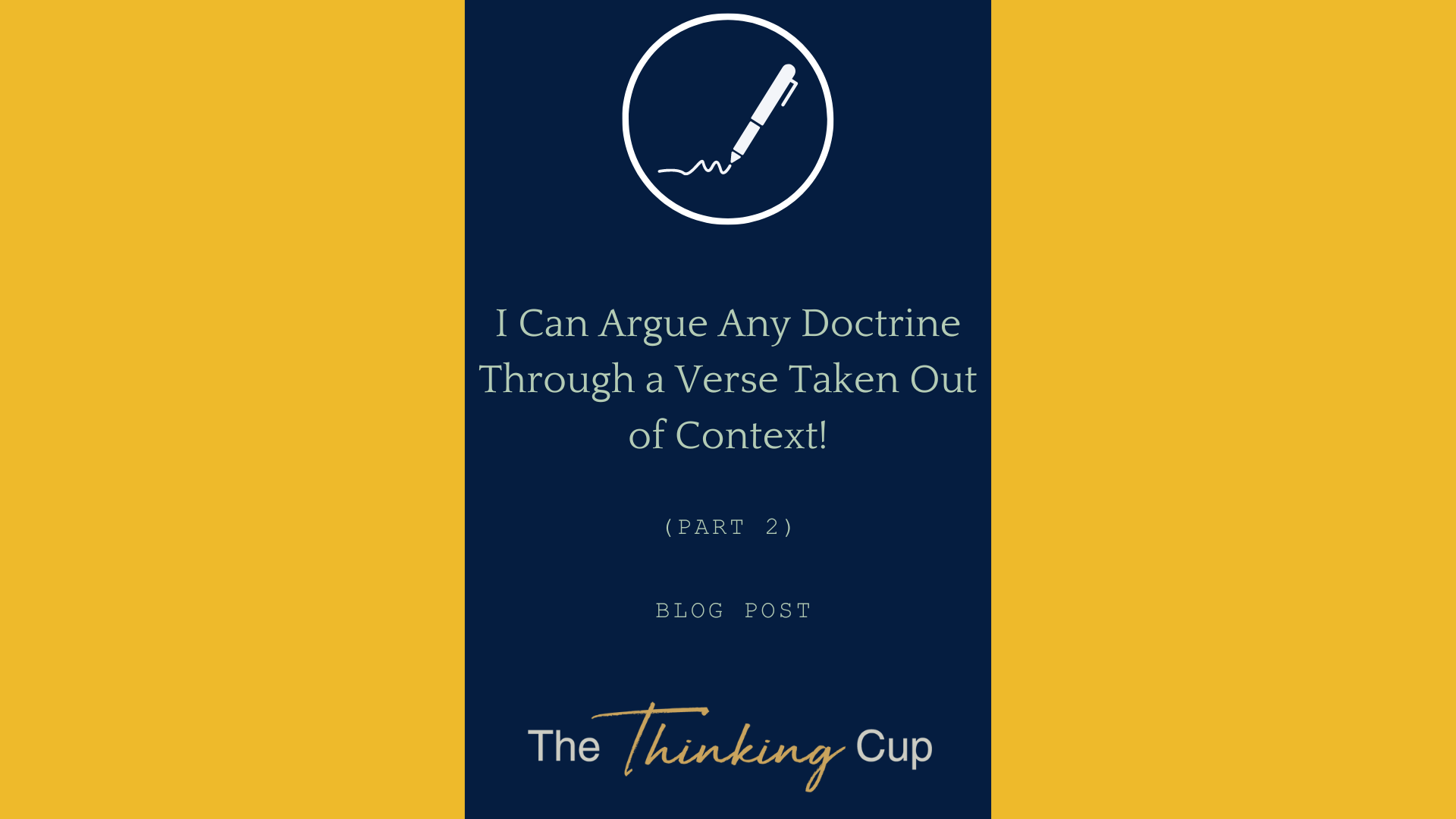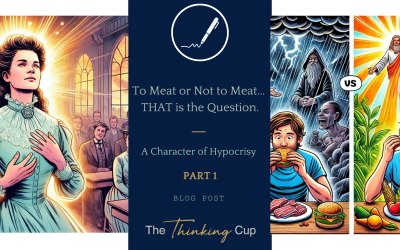We are continuing our discussion on context and how the context of a Bible text is misused in many Christians’ discussions but most certainly is misused in the Adventist framework. (If you need to catch up on Part 1 you can find it here.)
Here is the faulty hermeneutical principle and assumption we are discussing:
Adventists and other Christians knowingly and unknowingly ignore Scripture’s contexts (the covenantal, historical, cultural, theological, political, social, audient, immediate context, and the context that created the verse being quoted or discussed).
If you spend any amount of time with an Adventist or in an Adventist church/community, you are bound to begin to hear the importance of eating ‘biblically.’ 1 Corinthians 3:17 is a popular proof text used by Adventists when they promote, defend, or argue for the continued obligation of the Levitical dietary distinctions and restrictions for Christians.
“If anyone destroys God’s temple, God will destroy him. For God’s temple is holy, and you are that temple.” (1 Co 3:17)
When viewed out of Paul’s dialogue with the church in Corinth, the vegan/vegetarian Adventist EGW health advocate will prove the verse to mean that God will destroy Christians for eating pork and other unclean meats that the Law forbade. They will usually connect this verse with Isaiah 66:17 to bolster their position.
“Those who sanctify and purify themselves to go into the gardens, following one in the midst, eating pig’s flesh and the abomination and mice, shall come to an end together, declares the LORD.” (Is 66:17)
But again, if we keep our interpretation inside the context, in 1 Corinthians 3:17, Paul states that God will destroy some people for dividing the church with strife, jealousies, carnality, and factions and attempting to build on false foundations instead of building on Jesus Christ.
Quoting an Old Testament verse from Isaiah and ripping it out of its context to bolster a miss-interpreted opinion from 1 Corinthians 3:17, all while not realizing that the Adventist stance is usually coming from a Gentile Christian and not from a Jew (who had a reason to care about the Levitical dietary Laws), is just blatant miss use of Scripture and twisting it to manipulate the behaviors of people today.
Adventists also like to use Exodus 20:8-11 to mandate salvational Sabbath-keeping for Christians, but they ignore the Sabbath’s covenantal context. They attempt to separate all the other 603 laws from the 10 Commandments and claim that those 603 laws fall under ceremonial or civil laws. As such, those are the laws that were nailed to the cross. But the Ten Commandments are eternal and forever binding on humanity. (To better understand the fallacy behind the ‘eternal and binding’ concept, read the blog series starting here.)
But all these wild scriptural gymnastics are to miss the point. The Sabbath was given to Israel as their specific covenant “sign” between God and themselves to demonstrate that he had saved them from Egyptian slavery, set them apart as a particular people, and that He was their God (Exodus 31:13,17; Deut. 5:15; Ezek. 20:12,20). Covenants in the Old Testament were special relationship arrangements between two parties, with specific things to bring to the oath pledge. The Lexham Bible Dictionary puts it this way:
“A sacred kinship bond between two parties, ratified by swearing an oath. Covenant-making was a widespread custom throughout the ancient Near East and Graeco-Roman culture, serving as a means to forge sociopolitical bonds between individuals or groups. God’s covenants are prominent in every period of salvation history. Divine covenants reveal the saving plan of God for establishing communion with Israel and the nations, ultimately fulfilled by the death and resurrection of Christ.” [1]
The first question I would ask is, “What covenant arrangement are we currently under as Gentile Christians? Are we under the Mosaic Covenant? Are we required to become Jews and therefore follow the Jewish requirements?” No, absolutely NOT! In fact, this is precisely what was discussed at the Jerusalem Council around AD 50, about 20 years after Jesus’ resurrection. We find the details of the meeting recorded in Acts 15:1-29. It was during this meeting of the minds that Peter, Paul, Barnabas, James, and the other elders (with the blessing of the Holy Spirit) determined that, under the New Covenant, Gentile believers were not required to be circumcised or keep the Law of Moses. They were not commanded to keep the Sabbath Laws, the feasts, the Levitical dietary laws, the purity laws, or any other civil or ceremonial observances. Instead, they were given just four restrictions that were intended to build unity with their Jewish brothers and sisters in Christ:
- Abstain from things that have been sacrificed to idols.
- Abstain from blood.
- Abstain from anything that has been strangled.
- Abstain from sexual immorality.
They claimed that only these things needed to be followed from Jewish customs to remain unified in Christ. These things were not required for salvation but would help unify the Gentile and Jewish Jesus followers and prevent unnecessary friction.
Notice that the Sabbath, circumcision, the 10 Commandments, etc. are NOT mentioned. They were NOT required to worship on a specific day for salvation. However, Adventists have missed the mark on this idea, allowing Ellen White to read into the ‘correct interpretation’ of the Word of God. Unfortunately, Ellen White’s interpretations have confused the Bible and caused much unnecessary harm to the Body of Christ! Christians are not under the Old Mosaic Covenant. Therefore, they are not obligated to keep the Old Covenant sign — the Sabbath– or any other Old Testament law. One might want to honor a particular Old Testament custom, but there is no obligation to the Old Testament laws to come before God or be saved.
The Seventh-day Adventist church is fixated on the mark of the beast and feels compelled to share with others the ‘truth’ so that others won’t unintentionally get the mark. The proof-texts that are used to propagate this teaching is Revelation 13:11-18. Adventists believe that Christians will, sometime in the future, receive that mark of the beast for worshipping God on Sunday. The day itself is the primary function of the mark of the beast. Ellen White wrote about this in a Review and Herald article written on July 13, 1897:
“If the light of truth has been presented to you, revealing the Sabbath of the fourth commandment, and showing that there is no foundation in the word of God for Sunday observance, and yet you still cling to the false Sabbath, refusing to keep holy the Sabbath which God calls ‘My holy day,’ you receive the mark of the beast. When does this take place?—When you obey the decree that commands you to cease from labor on Sunday and worship God, while you know that there is not a word in the Bible showing Sunday to be other than a common working-day, you consent to receive the mark of the beast, and refuse the seal of God. If we receive this mark in our foreheads or in our hands, the judgments pronounced against the disobedient must fall upon us. But the seal of the living God is placed upon those who conscientiously keep the Sabbath of the Lord.” [2]
It is essential to understand that the letter of Revelation, written by John, was sent out to the seven churches described in Revelation 1. I know this might seem trivial, but not remembering that this letter was sent to the churches can easily cause the modern reader to forget that the contents of Revelation should be understandable to the seven churches to which it was written. John wouldn’t be writing about things only a modern reader could understand. John was writing to Jews and Gentiles; after all, this was a post-Jesus Christian world, where both Jews and Gentiles were welcomed into the body of Christ. Gentiles weren’t being forced to keep certain Jewish sacred days to have the seal of God, or if they didn’t keep them, they would get the mark of the beast. Worship is at the center of the mark of the beast, but Adventists have applied their own Ellen White view to the text by asserting that a physical day, Sunday worship, is now what causes the mark of the beast to be applied to someone.
“The enigmatic mark of the beast (Rev. 13:16–18) also contains economic implications. The Antichrist will force anyone who wishes to buy or sell to receive some kind of mark ‘on their right hands or on their foreheads’. This imagery probably reflects the ubiquity of the imperial cults at the end of the first century, not least in Asia. Although no exact parallels to this practice have emerged, the mark could well have referred to an idolatrous imperial image on a coin or have corresponded in function to stamps on deeds of sale from the first-century world.” [3]
Many scholars who are not blinded by the Adventist worldview or forced to make scripture say what Ellen White claimed, have noted several important contextually relevant points.
“The term χάραγμα (Rev. 13:16) ordinarily implies an engraved mark or a seal impression, or inscription. The Roman government under Augustus had already been issuing (inscribed?) tesserae (tiles) as proof of entitlement to the periodic grain dole. [4] Presumably you got one when marked off on the roll, and then gave your tile in at the granary.” [5]
We don’t have the time, nor is the purpose of this blog post to adequately cover the context of John’s Revelation of Jesus Christ, but many scholars have written excellent books, articles, and monographs on the contextual possibilities of understanding Revelation.
“A number of New Testament commentators have seen a connection between Rome and its cult of emperor worship and the book of the Revelation. The reference in Revelation 17:9 to seven heads of the “beast,” which are “seven hills on which the woman [the great harlot] sits,” has been taken as a reference to the famed seven hills on which Rome was founded.” [6]
I bring this up because we often forget that the letter of Revelation would need to make sense to a first-century Christian. The primary point of the mark of the beast is the refusal to worship. If Christians refused to worship the imperial cult through the emperor and his image, they would face an economic boycott.
“When this historical background is understood, it becomes clearer how the young SDA church arrived at Sunday worship becoming the mark of the beast. Through the proof-text method of biblical interpretation, the early Adventists were basically interpreting scripture in light of what was happening around them, instead of interpreting scripture in light of scripture’s own background. They were placing emphasis on what scripture meant [to them], before emphasizing what scripture meant to its primary audience….Wrong hermeneutical approach. As demonstrated by some of our own scholars, their interpretation of these passages are exegetically flawed, as these passages have nothing to do with what our pioneers have interpreted them to be. Sadly, we, the religious children of the pioneers who live more than a century and a half later, with unprecedented scientific information in biblical studies continue to espouse such embarrassing theories regarding Rev 6:12-14, Matt 24:29-30, and Sunday being the mark of the beast, as per Rev 13. Again, the biblical scholars of our church are doing our members a disservice on these issues.” [7]
The mark of the beast was never about Christians ceasing from labor on Sunday and worshiping God. And if it has any future implications and applications, it will not be about that either. Worshiping God on Sunday was never forbidden in the Old Testament, nor is it ever prohibited in the New Testament. Find one verse that makes this claim and then prescribes the level of damnation that Ellen White and the Adventist church place on worshipping God on Sunday. Find one verse. You can’t! This concept is never presented in Scripture or Church History as something satanic, the mark of the beast, or apostasy towards God that will damn Christians. This epitomizes reading a modern Ellen White context into the Bible and then twisting texts to mean what she said.
[1] Scott Hahn, “Covenant,” in The Lexham Bible Dictionary, ed. John D. Barry et al. (Bellingham, WA: Lexham Press, 2016).
[2] The Review and Herald, n.d., 2357.
[3] Craig L. Blomberg, Neither Poverty nor Riches: A Biblical Theology of Material Possessions, ed. D. A. Carson, vol. 7, New Studies in Biblical Theology (Downers Grove, IL; Leicester, England: InterVarsity Press; Apollos, 1999), 237.
[4] Suetonius, Aug. 40.2, 42.3.
[5] Edwin A. Judge, “The Mark of the Beast, Revelation 13:16,” Tyndale Bulletin 42, no. 1 (1991): 159.
[6] James S. Jeffers, The Greco-Roman World of the New Testament Era: Exploring the Background of Early Christianity (Downers Grove, IL: InterVarsity Press, 1999), 102.
[7] Baldwin, The Person of Jesus: God’s Obligatory Sabbath. Pg.285-86




0 Comments